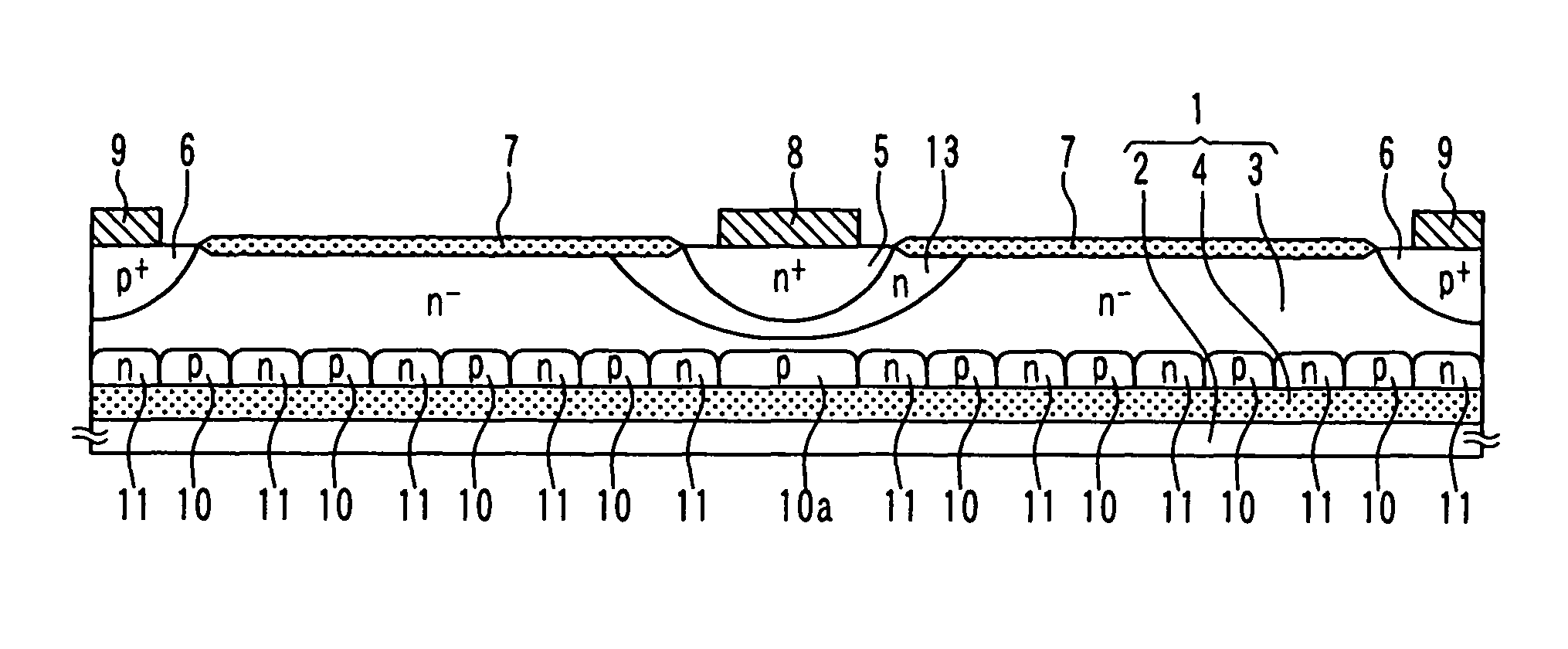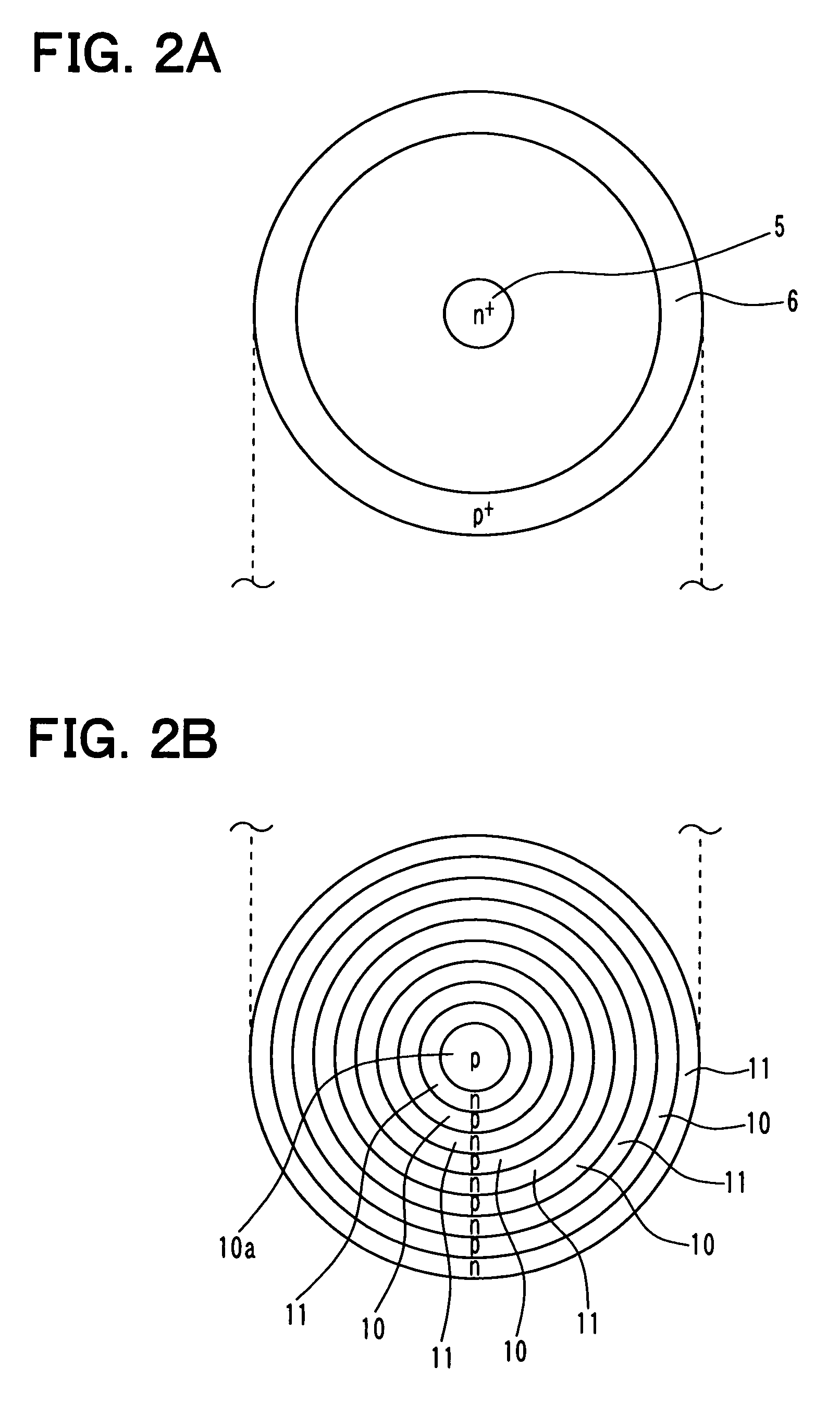Semiconductor device having SOI substrate
a technology of semiconductor devices and substrates, which is applied in the direction of semiconductor devices, basic electric elements, electrical appliances, etc., can solve the problems of complex manufacturing process and complicated manufacturing process of semiconductor devices, and achieve the effects of preventing breakdown voltage reduction, reducing device dimensions, and high breakdown voltag
- Summary
- Abstract
- Description
- Claims
- Application Information
AI Technical Summary
Benefits of technology
Problems solved by technology
Method used
Image
Examples
first embodiment
[0060]First embodiment will be explained. In the first embodiment, a semiconductor device has a lateral PN diode as a semiconductor element. FIG. 1 shows a cross sectional view of the semiconductor device. FIGS. 2A and 2B are a top surface layout and a backside surface layout of the device.
[0061]As shown in FIG. 1, the device is formed from a SOI substrate 1. The substrate 1 is prepared such that a support substrate 2 made of a silicon substrate and an active layer 3 are bonded to each other via an embedded insulation film 4. The embedded insulation film 4 is made of an oxide film or the like. The active layer 3 is prepared such that a N− type silicon substrate is thinned. The active layer 3 is divided into multiple element separation regions by an element separation structure. The PN diode is formed in one element separation region surrounded with the element separation structure.
[0062]The thickness of the active layer 3 is, for example, 5 to 25 micrometers. A N+ type cathode regio...
second embodiment
[0086]A second embodiment will be explained.
[0087]FIG. 6 shows a semiconductor device according to the present embodiment. FIGS. 7A and 7B show an layout view and a lower layout view of the device. In the device, a trench separation structure 20 for surrounding the outer periphery of the anode region 6 is formed. The trench separation structure 20 includes a groove 21 and an insulation film 22. The groove 21 is formed on the surface of the active layer 3, and reaches the embedded insulation film 4. The insulation film 22 is filled in the groove 21. For example, a mask formed by the photo etching method is used for etching the active layer 3 so that the groove 21 is formed. Then, the insulation film 22 is filled in the groove 21 such that a thermal oxidation process is performed, or an insulation material is deposited in the groove 21. Thus, the insulation material is filled in the groove 21. Thus, the trench separation structure 20 is formed.
[0088]The trench separation structure 20 ...
third embodiment
[0089]A third embodiment will be explained.
[0090]FIG. 8 shows a semiconductor device according to the present embodiment. FIGS. 9A and 9b show an upper layout view and a lower layout view of the semiconductor device. In the semiconductor device, a resistance type field plate 30 is formed on the PN diode via a LOCOS oxide film 7. The resistance type field plate 30 is made of, for example, a high resistance layer such as non-doped poly silicon. The resistance type field plate 30 extends in a spiral manner around the cathode region 5 as a center, and reaches the anode region 6.
[0091]In the resistance type field plate 30, a voltage drop according to the distance of the high resistance layer is generated between the cathode region 5 having the high electric potential and the anode region 6. The voltage drop is caused by an inner resistance of the high resistance layer. Accordingly, the voltage drops proportionally along with the radial direction around the cathode region 5 as the center ...
PUM
 Login to View More
Login to View More Abstract
Description
Claims
Application Information
 Login to View More
Login to View More - R&D
- Intellectual Property
- Life Sciences
- Materials
- Tech Scout
- Unparalleled Data Quality
- Higher Quality Content
- 60% Fewer Hallucinations
Browse by: Latest US Patents, China's latest patents, Technical Efficacy Thesaurus, Application Domain, Technology Topic, Popular Technical Reports.
© 2025 PatSnap. All rights reserved.Legal|Privacy policy|Modern Slavery Act Transparency Statement|Sitemap|About US| Contact US: help@patsnap.com



